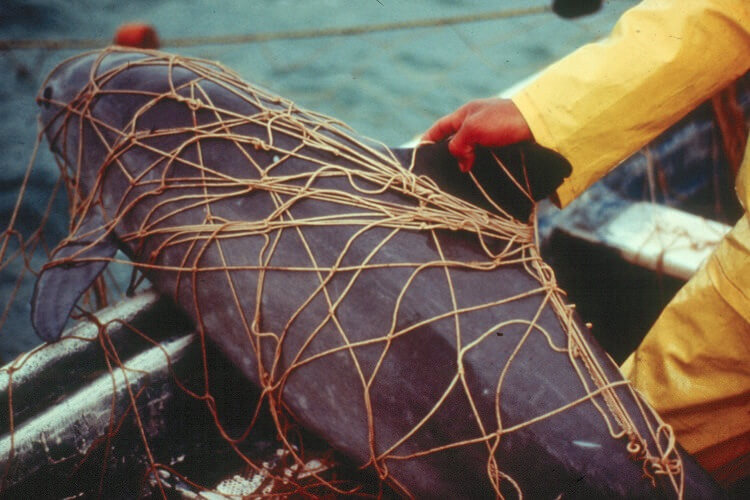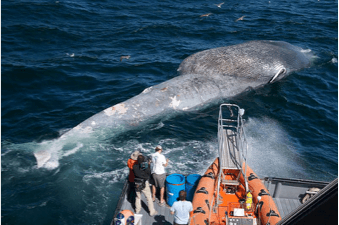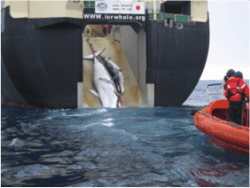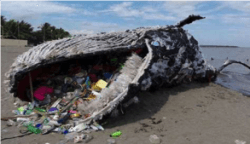Just like us, cetaceans (whales, porpoises, and dolphins) have a range of reasons that can lead to mortality. Because of this, when a dead whale washes ashore, finding the cause of death can often be like finding a needle in a haystack. Nevertheless, there are several reasons that we currently know of—mostly from necropsies of dead animals—and these reasons can be classified into two categories: natural and anthropogenic (direct or indirect).
Natural Causes
Cetaceans can simply die from old age. Their lifespan ranges from a few decades for harbour porpoises to over 200 years in case of bowhead whales. They can also die from predation from killer whales, polar bears or from sharks. This is especially prevalent in smaller species and calves of larger whales that are easy targets for the marine mammal predators.
Not only that, newly weaned and inexperienced individuals can easily get lost and become stranded. Furthermore, live individuals can die naturally from asphyxiation during individual and mass stranding events. In November, 2018, multiple stranding events occurred all over New Zealand: 145 pilot whales stranded on a beach on Stewart Island, 10 pygmy killer whales stranded at Ninety Mile Beach and a sperm whale was also found dead on Tokeroa Beach.
Moreover, whales can die from diseases, parasites and even difficulties during birth, just like us. Between 2009 and 2012, close to half of all St. Lawrence Estuary belugas that died were infected with Toxoplasma gondii—a parasite found in cats. Though the study did not find toxoplasmosis to be the primary cause of death in the stranded belugas, it could have resulted in a compromised immune system making them prone to diseases, including neurological deficits.
All these natural events, however, can sometimes be heightened by some threats posed by human beings.
Anthropogenic Causes
Studies prove that anthropogenic (human-caused) effects are the leading cause of mortality in certain species of cetaceans. These can be further divided into two: direct and indirect.
Following are a few of the anthropogenic effects that have a direct impact on cetaceans worldwide.
- Bycatch is a term given to non-targeted species in fishing. Fishery bycatches are a major threat to all marine species, including cetaceans. In fact, the International Whaling Commission (IWC) estimates that at least 300,000 cetaceans are caught this way each year. Vaquitas are currently on the brink of extinction because of bycatch in gillnets set for the totoaba fish in the Sea of Cortez. Entanglement is a subcategory of bycatch in which cetaceans and other marine organisms get tangled in active or derelict fishing gear. Depending on the type of gear, entanglement can prevent the animal from coming back to the surface to breathe or dive down for its biological needs. Either way, it ultimately leads to death.
- Oil spills are devastating to the lives of marine organisms that live in and around the area. Even after 28 years after the Exxon Valdez oil spill in Prince William Sound in Alaska, many marine species have not yet recovered. Among the most affected cetaceans were two different eco-types of killer whales that were seen swimming near the oil slicks after the spill. Result? The AT1 transients’ population dropped by 40% during the 18 months following the oil spill, and the AB pod residents lost 33% of their population.The latest spill has resulted in a leak of 250 cubic metres of oil off Newfoundland and can have devastating effects on many cetaceans and other marine organisms.
- Vessel strikes have been one of the leading causes of death for the endangered North Atlantic right whales in both Canadian and American waters. Blunt force trauma and propeller injuries are common signs of vessel strikes in cetaceans. Avoidance of a collision depends on the speed of the ship as well as the whale’s ability to detect and avoid ships.
- Whaling of cetaceans still exists today. Although a moratorium was adopted on large-scale whaling, according to the IWC, three types of whaling operations still exist around the world today: aboriginal subsistence, commercial and scientific whaling. Catch limits are set for each type by the IWC for member countries. Because Canada is not part of the IWC, Fisheries and Oceans Canada sets the quota for each species for subsistence whaling—the only permitted whaling in the country.
- Acoustic noise impacts all cetaceans, as hearing is their main sense. Our oceans are becoming increasingly noisier leading to an increase in difficulties in prey detection, navigation, and communication for their inhabitants. Previous studies also show a strong relationship between acoustic bursts, such as military naval sonars and seismic exploration, and mass stranding events.
- Aquarium trade of wild cetaceans has been around for decades. To add to the risk linked to the capture and the transportation, studies prove that most captive cetaceans suffer physically and mentally. Primary reasons for deterioration of health include: inadequate living conditions, artificial surroundings, limited social interactions, and behavioural restrictions. Additionally, when highly social animals are separated from their close-knit social units, their mental health gets jeopardized. These reasons often lead to their early mortality.
Following are a few of the anthropogenic effects that have an indirect effect on cetaceans worldwide.
- Chemical contaminants, such as polychlorinated biphenyls (PCBs) and polybrominated diphenyl ethers (PBDEs), pollute the marine environments and have been proven to be concentrated in the blubber layers of many cetaceans. Because of biomagnification—a phenomenon with which toxins and other substances increasingly accumulate at each trophic level of the food chain—cetaceans are at risk.
- Starvation from reduced prey availability due to overfishing or plastic ingestion causes cetaceans to slowly die. In a state of starvation, their bodies also start using up stored fat reserves, which makes matters even worse for them as it is these fat reserves that house the lipid-loving chemical contaminants.
- Climate change also affects them. For instance: reduced sea-ice cover and increased temperatures result in reduced prey availability and changes in migration patterns. Not to mention that depleting sea-ice cover is making way for more and more vessels in what were previously hard to navigate areas in the Arctic—exposing more cetaceans to potential vessel strikes. To add to that, increase in temperature affects many endemic species that have temperature specific habitat requirements.
- Plastic ingestion is one of the top anthropogenic threats that animals face around the world. Recently, an emaciated sperm whale washed ashore dead in Indonesia with 155 plastic cups and two flip-flops in its stomach. Accumulation of plastic can make them feel full all the time, preventing them from eating nutritious food. It can also perforate the stomach or the intestine. This ultimately leads to a slow death due to starvation.









